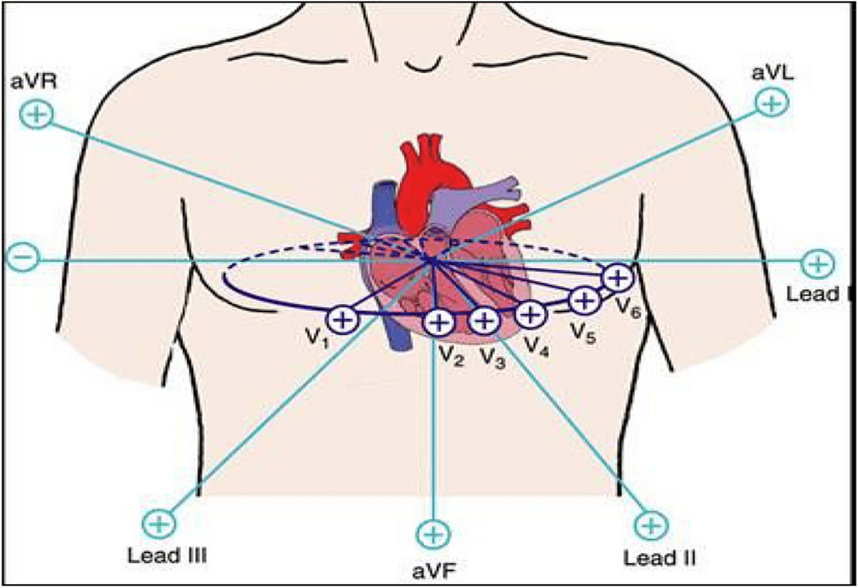A nurse is caring for a client who reports a new onset of severe chest pain. Which of the following actions should the nurse take to determine if the client is experiencing a myocardial infarction?
Perform a 12-lead ECG
Determine if pain radiates to the left arm
Check the client's blood pressure
Auscultate heart tones
The Correct Answer is A
Choice A reason: A 12-lead ECG can reveal changes in the ST segment, T wave, and QRS complex, which are indicative of myocardial ischemia, injury, or infarction. It is the first line diagnostic test that needs to be recorded within 10 minutes after the first medical contact in cases of suspected acute coronary syndromes.
Choice B reason: While pain radiating to the left arm can be a symptom of MI, it is not a definitive diagnostic action. It is a common symptom but can also be associated with other conditions.
Choice C reason: Checking the client's blood pressure is important in the overall assessment of the client's cardiovascular status but does not specifically diagnose MI. Blood pressure can be normal, elevated, or decreased in the case of MI.
Choice D reason: Auscultating heart tones can provide information about the presence of murmurs, gallops, or rubs, but it is not a specific diagnostic action for MI. Heart sounds may be normal during an MI.

Nursing Test Bank
Naxlex Comprehensive Predictor Exams
Related Questions
Correct Answer is C
Explanation
Choice A: Tachypnea Tachypnea, or rapid breathing, is not typically a direct sign of increased ICP. While it can be associated with various medical conditions, it is not specifically indicative of increased ICP. However, it’s important to note that breathing patterns can change with advanced ICP changes, but these are usually characterized by irregularities rather than just increased rate. Increased intracranial pressure (ICP) is a critical condition that can occur after a traumatic brain injury (TBI). It results from the brain tissue’s response to injury, leading to swelling or bleeding within the skull. The skull is a rigid structure, so any increase in content, such as blood or edema, can lead to an increase in pressure.
Choice B: Hypotension Hypotension, or low blood pressure, is generally not associated with increased ICP. In fact, one of the signs of increased ICP is Cushing’s triad, which includes hypertension (high blood pressure), bradycardia (slow heart rate), and irregular respirations. Therefore, hypotension would not be a typical manifestation of increased ICP.
Choice C: Decreased level of consciousness A decreased level of consciousness is a hallmark sign of increased ICP. As pressure within the skull increases, it can lead to compression of the brain tissue and disruption of cerebral blood flow. This can manifest as changes in alertness, drowsiness, confusion, and in severe cases, loss of consciousness1. when monitoring a client who has sustained a TBI, the nurse should be vigilant for signs of increased ICP, with a decreased level of consciousness being a primary indicator. Other signs may include headache, nausea, vomiting, and changes in pupil size or reactivity. It is crucial to identify and treat increased ICP promptly to prevent further brain injury and potential long-term consequences.
Choice D: Bilateral weakness of extremities While bilateral weakness can be a sign of neurological damage, it is not specific to increased ICP. Increased ICP is more likely to cause global effects on consciousness and brain function rather than isolated weakness in limbs unless there is focal brain injury causing raised ICP.
Correct Answer is D
Explanation
Choice A reason:Cardiac enzyme studies do not provide information about the heart's structure or the mobility of the heart valves; imaging studies are used for that purpose.
Choice B reason:While cardiac enzymes indicate damage to heart tissues, they do not pinpoint the exact location of an MI; imaging studies are needed for localization.
Choice C reason:Cardiac enzymes are not used to diagnose pulmonary congestion; they are specific markers for myocardial injury.
Choice D reason:Cardiac enzyme levels, such as troponin, rise when there is damage to the heart muscle, which is why they are used to assess the degree of damage after an MI.
Whether you are a student looking to ace your exams or a practicing nurse seeking to enhance your expertise , our nursing education contents will empower you with the confidence and competence to make a difference in the lives of patients and become a respected leader in the healthcare field.
Visit Naxlex, invest in your future and unlock endless possibilities with our unparalleled nursing education contents today
Report Wrong Answer on the Current Question
Do you disagree with the answer? If yes, what is your expected answer? Explain.
Kindly be descriptive with the issue you are facing.
